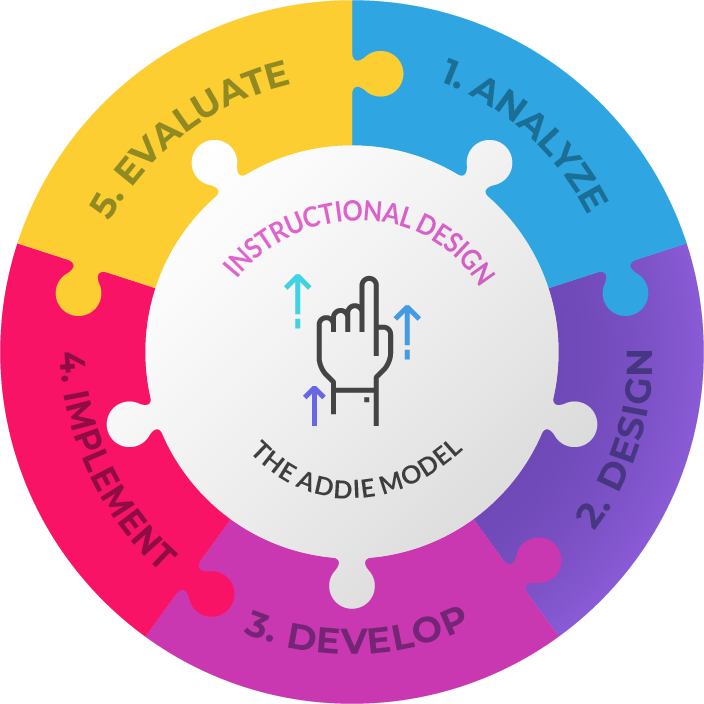View the interactive explanation of the ADDIE model in LesLinq.
Analyze
To start off, you need to learn about the target group, to ensure the content will be effectively adapted to their needs, preferences, level of knowledge and skills. All essential information that should be integrated into the content will be filtered here. You will formulate the problem, the potential solution or the desired situation. To explore this further you could ask yourself the following questions:
- What are the objectives and goals of the course you want to develop?
- What does the target group look like? What is their educational/professional background, age and are their experience, skills, and preferences?
- In what environment and with which tools does your target group learn best?
- What are the limitations of the design of this project? Are there time and/or budget constraints or a lack of technical skills?
Design
With the results from the analysis, you will start creating a learning design. Consider how best to realize your ideas.This step requires much attention to detail and should not be underestimated in terms of the time required. The process should be systematic and specific and the end product could take the form of a design proposal, document or concept. Questions to be asked are:
- What type of media do you want to use?
- What types and levels of activities will be integrated into the content? Think about interactive, collaborative or different types of content based on different groups in the participants
- What things do you make yourself? Are there elements you’re better off outsourcing? For example, see here how you can easily create interactive content with LesLinq.
- What design (fonts, colours) fit best the learning environment culture of your target group?
- How will the content be aligned and coordinated with/to the stakeholders?
Develop
The ideas in the design stage, will now be developed further into a working product. In the design phase, the content is formulated and during the development they are brought to life, testing what works and what doesn’t.
It is wise to start developing a prototype based on the information gathered in the previous steps. Are you developing an extended eLearning / course / training program? Then consider dividing the course into pieces. While one part is being assessed, you can work on the other part in the meantime. This can be a great time-saving approach. The process then consists of development, testing and redevelopment. Questions to ask in this process step:
- Is the the method of delivery ok?
- Are there any errors occurring?
- Komen er fouten voor?
- Do structure and content reflect the method of delivery?
- Are there any errors occurring?
Implement
Implementation of the product designed in the previous step is a continuous process which will be repeated until an optimal product is realized. You will be paying attention to both students (and instructors) and the course itself. Considerations to be made:
- Establish a way of recording both the data gathered and the experience of the participants around it.
- What level of guidance is needed when participants take the eLearning?
- Do you have backup plans when possible errors or failures occur. What is the course of action from there?
- What feedback do the participants express during the project on an emotional level, happy, confused, resistant?
Evaluate
Evaluation is done constantly, but after implementation, much effort is put into the review of the process and outcomes done, and how this can be improved. It ensures the constant feedback loop to stay on top of developments. Questions to be asked:
- By which points of measurement will you evaluate the effectiveness of your eLearning?
- Will the focus be sole on certain knowledge obtained or are there other relevant aspects which should be looked at?
- How will you determine if the instructions are clear? What the response rate is?
- What method will you use for collecting and analysing the feedback of participants, which is very valuable to continuously improve the project.
The ADDIE method is your guide in developing eLearning content, whether this is for educational, corporate or personal. It helps you to build the firm foundation your content needs to grow with the developments in the markets and preferences of the target group and ultimately gain maximum effect.
Wondering how to easily create interactive content yourself?
Create a free account on LesLinq and check it out! Questions? Contact us by email or call Chris Hof at +31 (0)682 077 845.

